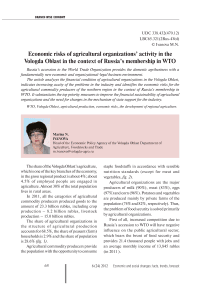Economic risks of agricultural organizations’ activity in the Vologda oblast in the context of Russia's membership in WTO
Автор: Ivanova Marina Nikolayevna
Журнал: Economic and Social Changes: Facts, Trends, Forecast @volnc-esc-en
Рубрика: Branch-wise economy
Статья в выпуске: 6 (24) т.5, 2012 года.
Бесплатный доступ
Russia’s accession to the World Trade Organization provides the domestic agribusiness with a fundamentally new economic and organizational-legal business environment. The article analyzes the financial condition of agricultural organizations in the Vologda Oblast, indicates increasing acuity of the problems in the industry and identifies the economic risks for the agricultural commodity producers of the northern region in the context of Russia’s membership in WTO. It substantiates the top priority measures to improve the financial sustainability of agricultural organizations and the need for changes in the mechanism of state support for the industry.
Wto, vologda oblast, agricultural production, economic risks, the development of regional agriculture
Короткий адрес: https://sciup.org/147223419
IDR: 147223419 | УДК: 338.432(470.12)
Текст научной статьи Economic risks of agricultural organizations’ activity in the Vologda oblast in the context of Russia's membership in WTO
The share of the Vologda Oblast’s agriculture, which is one of the key branches of the economy, in the gross regional product is about 4%; about 4.5% of employed people are engaged in agriculture. Almost 30% of the total population lives in rural areas.
In 2011, all the categories of agricultural commodity producers produced goods to the amount of 23.3 billion rubles, including crop production – 8.2 billion rubles, livestock production – 15.0 billion rubles.
The share of agricultural organizations in the structure of agricultural production accounts for 68.5%, the share of peasant (farm) households is 2.9% and the share of population is 28.6% (fig. 1) .
Agricultural commodity producers provide the population with the opportunity to consume staple foodstuffs in accordance with sensible nutrition standards (except for meat and vegetables, fig. 2).
Agricultural organizations are the major producers of milk (90%), meat (83%), eggs (97%) and corn (96%). Potatoes and vegetables are produced mainly by private farms of the population (74% and 82%, respectively). Thus, the problem of food security is solved primarily by agricultural organizations.
First of all, increased competition due to Russia’s accession to WTO will have negative influence on the public agricultural sector, which bears the brunt of food security and provides 21.4 thousand people with jobs and an average monthly income of 13,845 rubles (in 2011 ).
Figure 1. The structure of the agricultural production in the Vologda Oblast
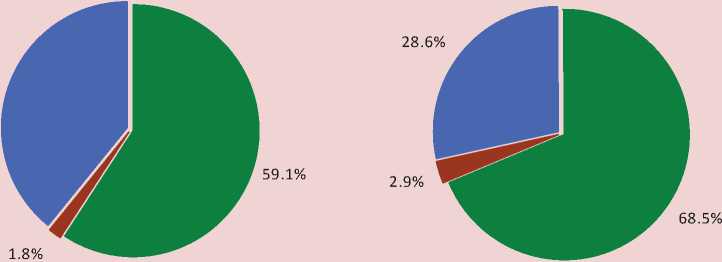
■ Agricultural organizations ■ Peasant (farm) households ■ Private farms
The situation can be aggravated by the problems of agricultural organizations, including low profitability, high debt load, a lack of government support, poor supply with technical equipment and, consequently, low production efficiency.
239 agricultural organizations that submitted their accounting reports for 2011 had the following results (fig. 3) :
-
• sales revenues of agricultural products, works and services amounted to 13706.8 million rubles (118% by 2010);
-
• cost of agricultural products sold amounted to 12841.0 million rubles (122%);
-
• before-tax profit (including subsidies) – 654 million rubles (83.8%).
Organizations’ account payable increased greatly due to ever-increasing energy products rates, prices for fertilizers, feed and other material and technical resources. Besides, they attracted more and more credit and borrowed funds incurring a heavy deficit of working capital.
The total loan indebtedness of agricultural enterprises amounted to 11.9 billion rubles (long-term and short-term) or 77% of the gross revenues at the end of 2011, and debt exceeded revenues in some organizations. Almost 8% of revenues are spent annually to service credits and loans; this sum is equal to 1.1 – 1.2 billion rubles which is comparable to the full volume of state support for the industry from the federal and regional budgets (tab. 1) .
These expenses are included in “miscellaneous costs” of organizations and along with subsidies (“miscellaneous income”) they affect the final result – the profit of organizations.
The share of profitable organizations amounted to 67% at the end of 2011 and their profit amounted to 1065.7 million rubles. The losses of 78 unprofitable organizations came up to 411.7 million rubles, which was 2.1 times more than in 2010.
And there are more companies that operate at a profit under 5 million rubles (119) among profitable organizations (161) including
Figure 2. Production and consumption of staple foodstuffs per capita per year, kg
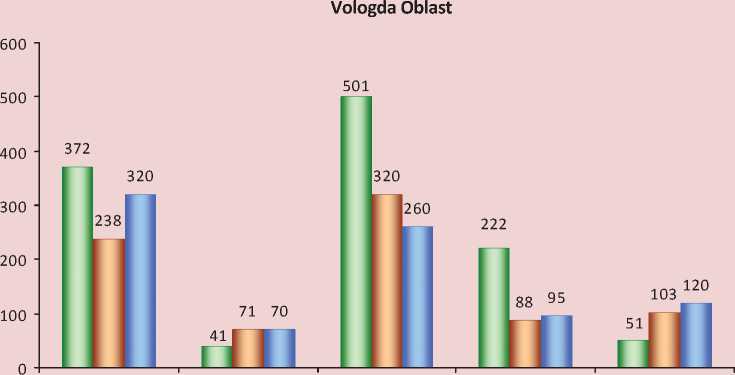
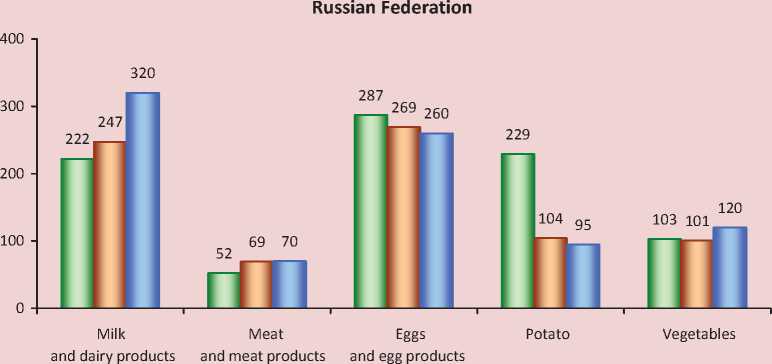
□ Production □ Consumption □ Physical standard
56 organizations which profit is less than 1 million (fig. 4) . This profitability leads to narrowing down of production and increases the risk for all the organizations.
-
• According to existing conditions, the Economic Policy Agency of the Department of Agriculture, Foodstocks and Trade analyzed a number of indicators (21) in order to find if their values correspond to standard (recommended) or optimal values of financial stability efficiency (effectiveness) and technical support of agricultural organizations.
Depending on the total values of these indicators, the organizations were divided into five risk groups:
-
• Group 1 (under 50 points) – the risks are within acceptable values;
-
• Group 2 (from 50 to 80) - increased risk;
-
• Group 3 (from 80 to 120) - high risks;
-
• Group 4 (over 120) - super-high risk;
-
• Group 5 – the organizations that have ceased their production activities or the company in liquidation, which financial recovery is nearly impossible.
Figure 3. Analysis of financial stability of agricultural enterprises in the Vologda Oblast
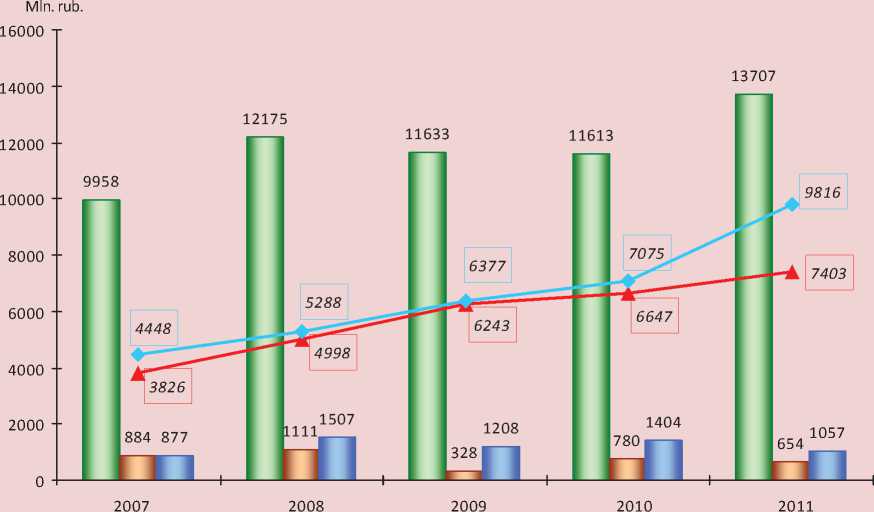

Table 1. Service costs of attracted credit resources by agricultural organization in the Vologda Oblast in 2008 - 2011.
|
Items of expenditure |
2008 |
2009 |
2010 |
2011 |
2011 in % to 2008 |
|
Credit and loan service by agricultural organizations – total, mln. rub. |
795.9 |
1064.9 |
1272.1 |
1205.1 |
151 |
|
Including: long-term |
466.7 |
569.7 |
756 |
718.9 |
154 |
|
short-term |
329.2 |
495.2 |
516.1 |
486.2 |
148 |
According to the Department’s estimates, there are 113 high risk organizations (from Group 3 to Group 5) in terms of operating in new economic conditions, or 47.3% of the total number of organizations. Moreover, there are 75% of high and super-high risk companies in six regions out of 26 ones; and there are the only high and super-high risk agricultural organizations in two regions.
The average annual number of employees amounted to 4960 people in high and super-high risk organizations in 2011(23% of the total number of agricultural employees); their average monthly wage accounted for 11,227 rubles. These organizations use 42% of the Vologda Oblast’s agricultural land, including 39% of arable land (173.1 hectares), and they have 23% of cattle stock, including 25% of cows (18.6 million head).
Figure 4. Distribution of the Vologda Oblast’s agricultural enterprises according to their profit before tax
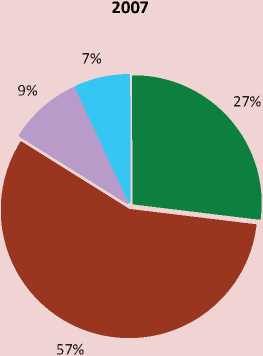
■ Unprofitable (87 households)
■ Profit under 5 million rubles (177 households)
■ Profit from 5 to 10 million rubles (27 households)
■ Profit over 10 million rubles (22 households)
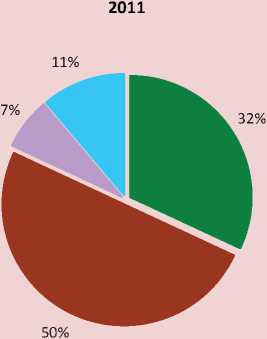
■ Unprofitable (78 households)
■ Profit under 5 million rubles (119 households)
■ Profit from 5 to 10 million rubles (16 households)
■ Profit over 10 million rubles (26 households)
In 2011, these organizations produced 25% of grain, 54% of rotted straw, 20% of milk, 10% of meat, 49% of eggs in the total production of agricultural enterprises. The share of long-term loan debt of these organizations amounted to 39% as of 1 January 2012; short-term loan debt was equal to 34%. The situation continued to deteriorate in the current year due to the reduction of state support (by 20% – from the federal budget and by 34.5% – from the regional budget).
In these circumstances, taking the level of state support of the industry for the criterion of development forecast, it is possible to calculate the bankruptcy of a third of agricultural organizations due to its further reduction and without the imposition of all the conditions and requirements of WTO. As a result, public small commodity production, which is located in the peripheral areas of the oblast and which is required mostly for providing employment and incomes of the rural population and implementing social control over the territories, will cease to exist.
If the state support is reduced, in 2013 agricultural commodity producers will be able to sow no more than 110 thousand hectares with corn in spring and 1.7 thousand hectares with flax; the lands under potato and vegetables can be maintained – about 20 – 21 hectares (including private households). There will be the following croppage from these sown areas: no more than 153.2 thousand tons of grain (62.5% in 2011), 233.3 thousand tons of potato (87.5%), 57.1 thousand tons of vegetables (94.3%), 0.2 thousand tons of flax seeds (45%), 1.2 thousand tons of flax fiber (42.9% to the level of 2011).
As for a livestock sector, it will be possible to produce no more than 430 tons of milk (96.3% to the level of 2011) and 67 thousand tons of meat and poultry on hoof (89.3% respectively). These amounts will be caused by the reduction in the number of cows in the public sector by 2.5 million head, by 5.3 thousand head in 2014 and by another six thousand head in 2015 (up to 73 thousand head).
As a result, milk production in all the types of households will be able to reach 370 thousand tons in 2015 (-76 tons to the level of 2011).
Further reduction of state support can lead to the general elimination of public agricultural production in 18 districts of the oblast (fig. 5) . As a result, 5 thousand people working in agriculture will be unemployed, which, in turn, will lead to the increase in budget expenditures for hardship allowances and providing low-income citizens with various benefits. Income of farmers amounted to 668.3 million in 2011 – it is the tax base for personal income tax, therefore, more than 86 million of this tax did not go to the budget.
There is a threat of regional food security due to the processes mentioned above, since the production of staple agricultural products will not meet the required standards of per capita consumption (fig. 6) . According to the figure, in 2020 the domestic production of staple agricultural products will be reduced by
30% on average with the minimal state support for the industry in the context of Russia’s membership in WTO; these figures will be below the standards of rational consumption. There will be a positive growth in agricultural production and foodstuffs with the maximal level of state support, workplaces and social control over vast territories of the oblast will be kept.
In order to minimize the negative consequences of Russia’s membership in WTO, the Economic Policy Agency of the Vologda Oblast Department of Agriculture, Foodstocks and Trade has developed a draft state programme “Development of agriculture and consumer market of the Vologda Oblast for the period from 2013 to 2020” for the Vologda Oblast’s agricultural sector by the Governor’s Order No. 13-SOV as of March 11, 2012 and in accordance with the regional government decrees No. 422 as of April 25, 2011 and No. 1629 as of December 22, 2011.
Figure 5. Forecast of agricultural development of the Vologda Oblast in 2020 in the context of Russia’s membership in WTO (with the minimal state support for the industry)
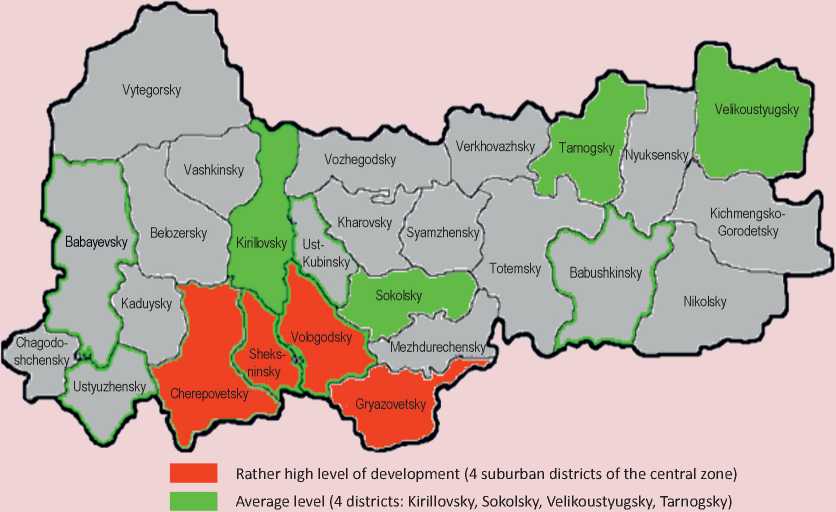
Low level (the rest 18 districts of the oblast where agriculture is maintained in the private farmsteads and collective farm enterprises akin to family farms)
Figure 6. Forecast of staple foodstuffs production per capita in the Vologda Oblast in the context of WTO with the different levels of state support for agriculture

о 2011 □ Norm и 2020 (with minimal sate support) П 2020 (with maximal sate support)
The project provides for the comprehensive development of all the sectors, sub-sectors and the spheres of agricultural activity in the context of Russia’s accession to the World Trade Organization. It will be possible to keep positive dynamics in the development of the industry, make conditions for its fast transition to a new technological base and increase its competitiveness only in the case of full funding of the state programme (the demand for budget funds will amount to 2390.7 million rubles in 2013).
It is proposed to introduce new subsidies for the partial reimbursement of milk production cost (commercial premium and first grade milk) as the state support for milk producers (most regional agricultural organizations). The subsidies for reimbursement of forage equipment purchasing costs will encourage farmers to transfer their production to a new technological level. It is proposed to introduce subsidies for the partial reimbursement of mixed fodder purchasing costs in order to ensure the state support for specialized organizations in the pig breeding and poultry farming sectors. Support for the food and processing organizations, especially regional dairy companies, will allow us to maintain their financial stability in the face of increased competition, raise production capacity, develop the logistics and promote value added goods under a single trademark “ Vologda Made Product”.
In addition, the following measures will be necessary to overcome the possible negative consequences of Russia’s membership in WTO: the extension of a number of tax incentives for agricultural producers (in particular, zero profit tax rate) at the federal level; keeping the remission of property and transport taxes for all the agricultural organizations at the regional level.
It is proposed to increase the investment attractiveness of agricultural industries due to providing tax holidays for the period up to 5 years for the agricultural organizations, implementing investment projects that are socially and economically important.
The proposed measures will contribute to the financial sustainability of agribusiness organizations, they will minimize the risks of bankruptcy and liquidation of public agri- cultural production and, therefore, they will prevent the growth of unemployment and social tension in the vast territories of the region. At the same time, the economic activity of agricultural organizations, the use of their hidden reserves, saving material costs, audacious implementation of advanced and innovative technologies will allow us to achieve a significant effect and raise the industry to a new level of development.
Список литературы Economic risks of agricultural organizations’ activity in the Vologda oblast in the context of Russia's membership in WTO
- Agricultural sector and consumer market of the Vologda Oblast in figures. Vologda Oblast Department of Agriculture, Foodstocks and Trade. Vologda, 2012.
- Analysis of production and financial activity of agricultural organizations in the Vologda Oblast in 2011. Vologda Oblast Department of Agriculture, Foodstocks and Trade. Vologda, 2012.
- State programme for the development of agriculture and regulation of agricultural commodities markets in 2013 -2020: approved by the Decree of the Government of the Russian Federation as of 14.07.2012. No. 717. Available at: http://www.consultant.ru/law/review/77253/html.
- State programme for the development of agriculture and consumer market of the Vologda Oblast in 2013 -2020. Vologda Oblast Department of Agriculture, Foodstocks and Trade. Available at: http://www.vologda-agro.ru/images/stories/Information/Other_documents/00018.pdf
- Naumkin A.V. Improving the forms and methods of state support for the agricultural development in the context of Russia’s accession to WTO. Economics of agricultural and processing enterprises. 2012. No. 3. P. 33-37.
- National report “On the 2011 progress and results of the State programme for the development of agriculture and regulation of agricultural commodities markets in 2008 -2012”: approved by the Decree of the Government of the Russian Federation as of 01.06.2012 No. 881-р. Ministry of Agriculture of the Russian Federation. Available at: http://www.mcx.ru//navigation/docfeeder/show/342.htm.
- Development strategy of the Vologda Oblast’s agriculture and the consumer market till 2020: approved by the Decree of the Government of the Vologda Oblast as of 30.05.2011 No. 591. Krasny Sever. 2011. No. 102.
- Uzun B. Evaluation of the effects of Russia’s accession to WTO for agricultural producers. Economy of Russia’s Agriculture. 2012. No. 8. P. 12-18.
- Federal Law “On the Development of Agriculture” No. 264-FZ as of December 29, 2006. Available at: http://www.consultant.ru/law/review/77253/html.
- Holod L. Russia’s accession to WTO and the development of agricultural sector. Economy of Russia’s Agriculture. 2012. No. 6. P. 22-25.
- Yeldiyeva T.M. Improving the special-purpose programme for solving the problems of regional agriculture. Economics of agricultural and processing enterprises. 2011. No. 10. P. 12-18.

